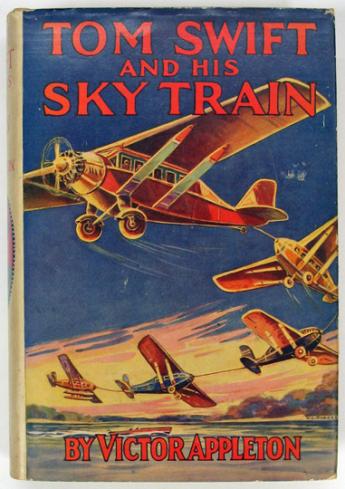Tip Antiquarian Booksellers' Association of America Tavistock Books
Collecting Rare Books and First Editions: "Every Boy Needs A Hero"

By Vic Zoschak
American boys, in the first half of the 20th Century, often found their heroes in print, tantalizingly displayed on the shelves of the corner drugstore. These heroes usually took two forms: the superhero, such as Superman, the Green Lantern, Spiderman, etc, who populated the comic book pages published, primarily, by DC and Marvel. Their other heroes were of the mundane, albeit of an idealized nature. Tom Swift. The Hardy Boys. Their ilk, the genre known as 20th Century Boys' Serial Fiction, shall be the subject of this short essay.
Boys' Serial Fiction was not new to America's youth as the 19th Century turned to the 20th ... Beadle & Adams, for example, had been publishing lurid dime novels for decades, however, 1910 saw the introduction of Tom Swift, by the 20th Century king of Boys' Serial Fiction, Grosset & Dunlap of New York, a phenomenon to which I attribute the birth of this 20th Century genre. Victor Appleton ostensibly was the author, an appellation we now know to be a Stratemeyer house name.
Beginning with Tom Swift and His Motorcycle, which was issued as the first title in a 'breeder' set of 5, the series continued through 1935, with a new title published [for the most part] annually. The series attraction & success can be gauged by the fact that a Tom Swift Jr. series was launched in 1954 and continued through 1978; in the 1990s, Applewood reissued the first 3 original titles in [a close] facsimile; and last year, Easton issued the first 6 titles in their deluxe leather format.
While Tom Swift was, perhaps, the most successful of all boys' series books issued by Grosset & Dunlap, if one peruses Mattson's & Davis' monumental work, A Collector's Guide to Hardcover Boys' Series Books [1997], hundreds of other series will be discovered, and a collecting challenge will be born.
And who would rise to such a challenge to collect such books? Why, many a young lad of decades prior, now a man of maturity, fondly remembers the hours of pleasure reading, for example, the many mystery-solving exploits of Frank and Joe Hardy, the main characters of Franklin W. Dixon's Hardy Boys series. Our mature men now wish to recreate the library they had when they were in their teen years ... and they have the money & wherewithal to do so.
And, for the booksellers out there, some of these books are quite rare, have significant pent-up demand, and consequently, will command sums worthy of your attention.
To illustrate: the early Tom Swifts in jacket - 4 figures, and one Hardy Boy title will readily bring five figures for a nice 1st in jacket. Other examples could be provided, but I think these two adequately convey the point that the genre is active, and potentially profitable .
However, the field is rife with books misidentified as 1st editions, primarily those titles from the second tier houses, such as Grosset & Dunlap, A. L. Burt or Altemus. What most sellers fail to check are the advertisements, both in the book & on the jacket. A book almost certainly is NOT a first edition if titles published, say, 3 years later are listed in the book's advertisements.
Sadly, there is no definitive bibliography for most series; the Mattson & Davis book already mentioned must be described as a checklist, vice true bibliography. The one series to have been subject to methodical study was the Hardy Boys, by one Charles Heffelfinger who published the Bayport Companion [1], which does provide a bibliographical approach to edition identification. And one series book publisher has also been subject to such study, which resulted in Cary Sternick's recent work, The Henry Altemus Company: A History and Pictorial Bibliography.
Years ago, pre-Internet, collectors would often be satisfied with any copy that came their way, just for the opportunity to fill the slot for a title missing from their collection. Now, however, with AddAll.com, and other such book finding aids, collectors have access to more bookstores, and more choices from which to select. As a result, books without jackets, unless truly rare, have become almost unsalable, and copies with jacket now are now de rigueur.
Given the artwork that graces many of the series, this collecting trend is certainly understandable; in many cases, when found in fine condition, the artwork is nothing short of fantastic, as I trust the associated image illustrates. And, of course, the books command a significant premium when their jackets can be described as ' fresh, with vibrant colors'.
As a bookseller, I must consider future collector trends, so I wonder at the 'legs' of this genre, for my clientele for these books definitely is, for the most part, past 45 years of age. So what bodes the future? To be honest, I see it trailing off somewhat as my generation ages ... not that boys will no longer need a hero, they will, but will Tom Swift continue to fill that role?
Perhaps not, though I do expect that great dust jacket artwork to continue capturing some, if not as many, imaginations.
[1] 3rd edition, 1996. There may be a later one, of which I’m unaware. Also: Tony Carperntieri & Paul Mular, Hardy and Hardy Investigations [Synsine Press: 2004]
The collecting tip was published on www.sheppardsconfidential.com, it is presented here by permission of the author.
